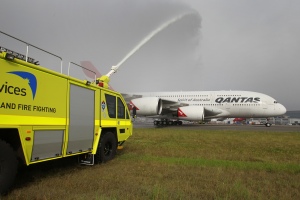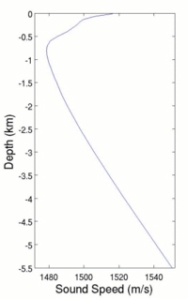Question # 6

Airservices Aviation Rescue and Fire Fighting fire vehicles welcome home VH-OQA Nancy-Bird Walton at Sydney Airport. (Courtesy AirServices)
See also: Physics for the Coffee Table (PFTCT)
Situation
A major city (population 5 million) is planning to build a new airport at a new location inside the city. Two sites are proposed: one beside the ocean and one twenty kilometers inland from the ocean.
Consider the noise levels originating from aircraft taking off from both airports. Ignore the noise from airborne aircraft.
Question
Which airport provides the quietest noise footprint for any single resident who lives an equal distance from either airport? Why?
Quiz Prize
The winner will be announced at noon London time on Monday 15th April 2013. The winner may chose their prize from the selection of Category 1 prizes.
Other Information
Free postage to the winner world-wide.
Thanks
The QF32 Web Site Crew thanks Pan Macmillan and Airbus for providing these excellent prizes.
We welcome prize offerings from other vendors who wish to participate in this fun competition.
Winner
There were no winners for this week’s question!
Answer
Inland airports have larger noise footprints than coastal airports.
This phenomena occurs due to the effects of temperature inversions that develop more intensely inland than they develop along the coast. The warm oceans reduce the incidence of Radiative Temperature Inversions.
This is one of the many reasons why coastal airports are quieter than inland airports.
Food for thought.
Incorrect answer . Although it is true that land and sea breezes affect the sound footprints, these two air flows generally alternate every twelve hours and so the opposing effects cancel each other out over the period of a day.
Explanation
See also: Temperature Inversions and thermoclines
Atmospheric air temperature normally decreases with height in the lower atmosphere.
A Temperature Inversion exists when the air temperature increases with height.
Radiative Temperature Inversions (or thermoclines) form on clear nights when the radiation from the Earth’s warm surface travels out to space rather than being reflected back to the surface by clouds. When this terrestrial heat energy is lost, the surface cools faster than the insulating blanket of air that lies above that surface. In the extreme cases of cooling, thin layers (a few metres high) of Radiative Fog form when the surface temperature of that air lowers to its dew point.
The speed of sound is faster in warm air than in cool air. Similar to the effect of light being refracted (bent) as it passes through a lens, sound is refracted (bent) as it passes though air masses of changing temperatures.
Surface sound is refracted (bent) skywards on a normal day in conditions where the temperature decreases with altitude. Conversely, on a clear night when a Radiative Temperature Inversions exists, this temperature “lens effect” refracts surface noise back towards the ground (colder air). So on a clear night, the sound of an aircraft taking off is guided down towards and tunneled along the ground. This effect may be so pronounced that an observer above the airport might hear nothing!
Oceans reduce the incidence and severity of Radiative Temperature Inversions. On a clear night, water cools at about half the rate as land. So Radiative Temperature Inversions will form faster and more intensely over land than over water. So the noise footprint from coastal airports is less that the noise footprint from inland airports.
There are many other practical examples of thermoclines:
-
Submariners survive by relying on changes in water density to refract and tunnel their submarine’s sound, keeping the sound in deep layers below the detection range of surface craft. For example, the “SOFAR” tunneling channel is normally found at about 600 metres depth where the slowest local speed of sound in water is located. Additional tunnelling channels are also created at other boundaries where the water density changes (a function of temperature, pressure, salinity …). In the case of flight data recorders, the channeling layers refract the “pinging” sounds rising from the deep ocean floor, bending them to align with what is best described as an effective sound equivalent of an optical “fibre cable” or transmission “wave guide”. The result is that the rising “pinger” sound flattens out and radiates outwards horizontally (akin to the top of a thunderstorm that rises to the tropopause) rather than continue upwards to reach ocean surface. This theory explains why sea microphones must be lowered down below the depth of the channels to hear the sound from flight data recorders and submarines.
- Views of a mirage (of a lake of water) in the desert is really just visions of light from the blue sky light that has been splayed (refracted) horizontally into your eyes.
On a clear night, a thermocline forms when the Earth cools, the lens effect funnels sound to you from cars, trains, and aircraft located tens of kilometers away. Everyone has heard the unmistakable and confusing sounds from trains that are known to be normally too distant to hear. During my childhood in Melbourne, I clearly remember hearing the sound of aircraft taking off from Tullamarine Airport that was located over twenty kilometers away.







Richard, it was great that this was a tough one!
Neil thanks for your support, but I think that I strayed. PFTCT questions are meant to be understandable to a ten year old (accepting that the answers might not). I went a bit tangential with this question, possibly because of the the discussions that are surrounding the decisions made by many governments that are designing and locating new airports.
Your PFTCT questions spark plenty of dinner table conversation with my 11 year old!
Dear Captain, good day!
My choice in that question would be the location near the sea.
The reason for that selection is as follows.
During the DAYtime due to a HIGH pressure system aloft over the LAND, there will be a sea-breeze on the surface, blowing ONshore. By doing so, it would of course carry the “noises” over land and towards the city.
However, during the evening the land will cool much faster than the sea, thus a LOW pressure system aloft would be created over land. Aloft the air will flow towards the shore, which will cause a rise in air pressure on the surface over the land. This rise in air pressure near the surface will result in an OFFshore surface wind, which of course is known as land-breeze. This wind will carry the “noises” away from the city and its sleeping inhabitants. So there will be less disturbance during the important resting hours during the night.
Best regards,
Alex
Captain, I would consider the location beside the ocean. My reason is as follows:
Due to the circulation of land and sea wind, during the day (sea breeze blowing ON shore) the “noises” would of course be carried over the city. However, as the air over land cools faster than over during the hours of the evening, there will be a high aloft over the water causing the air to flow towards the low aloft over land. This will result in a rise in air pressure at surface level over land from which the air will flow OUTwards over the water (land breeze blowing OFF shore). So during the hours of the night the wind that blows seawards will blow the “noises” away from the people and thus not disturb their night sleep. So, as said already, my choice would be the place near the sea.
Hope I’m right with that:-).
Best regards,
Alex
The sea location is preferred because aircraft can takeoff over water and away from the “citizen”. We can see that at every major airport near the sea – overwater departures for noise abatement 🙂
Airport besides ocean more likely quieter since sea air typically more humid and warm. Humid air attenuates sound more then cool denser air inland
Cheers Damian
I can think of many factors that would influence the answer including number of aircraft movements, day versus night operations, departure corridors, runway directly, aircraft used, curfews etc so I am probably way of the mark with my answer but here goes…
I want to concentrate on the effect of temperature has on pressure and thus winds (as all winds are caused by differences in pressure), namely the effect of sea and land breezes. There are many factors but lets consider the following.
The sea warms more slowly than land as the sea has a greater heat capacity (this is why, by the way, water cooled equipment racks in various technical areas are becoming more common that simple air cooling). The temperature difference causes an area of lower pressure over the warmer land and forces the higher pressure cooler air from the sea to move inland (a sea breeze). The opposite occurs at night as the land cools more quickly than the ocean (due to heat capacity) and the pressure difference is reversed causing the wind to move from the land to sea.
This is, I accept, a simplistic view.
Given there are likely to be many more aircraft movements during the day, particularly afternoon and into the early evening, then I would suggest the inland location is likely to be quieter for the resident living equidistant from each proposed airport location because the prevailing sea breeze will tend to cause noise from the coastal airport to be carried inland.
Probably totally wrong but it is always fun to try 🙂
The inland airport offers the quieter noise footprint. The ocean-side airport is “noisier” because over the sea sound travels quicker (as well as over larger distances) than it does over land.
Sound is greater with an airport by the ocean.
When the airport is located by the ocean, the sound travels at sea level. Sound travels faster when reflected near water as it is amplified. This amplification effect can be multiplied when wind is prevalent creating an area where sound is greater.
When the airport is further away from the ocean, sound travels faster at a greater height as the land is higher than sea level. Since the resident is 10 km away and below the height of the inland airport. There would be a negligible effect on the resident’s noise footprint.
Oops. Someone’s timezones are confused 😦
That was 8pm Sydney, not 9
I’m making all this up but winds blow from the sea more often so more takeoffs towards the sea at a coastal airport. Most of the sound goes backwards and so it’s more noisy behind a coastal airport and that’s where the people are.
Definitely something wrong with the time zones on the site. I posted that at 9pm, not 10pm as the post says. And the question went up at 8pm Sydney not 9 as advertised.
Hi Kevin, Yes you are right. The daylight saving was not updated on the site. It’s now fixed. Thanks for your feedback! [Ed]
That’s an apt answer to a very interesting question.
Take offs create the most noise, and a regular on shore sea breeze will make sure that most takeoffs are over the sea, so the sea shore location would minimise the noise level for any particular location on land.
Sound is greater with an airport by the ocean.
When the airport is located by the ocean, the sound travels at sea level. Sound travels faster when reflected near water as it is amplified. This amplification effect can be multiplied when wind is prevalent creating an area where sound is greater.
When the airport is further away from the ocean, sound travels faster at a greater height as the land is higher than sea level. Since the resident is 10 km away and below the height of the inland airport. There would be a negligible effect on the resident’s noise footprint.
I believe the determining factor here will be the speed of sound in the air between the airports and the resident. The higher the local speed of sound the further the noise will travel.
Sound travels faster in less dense gasses than gasses which are dense. This is because the molecules are spaced further apart, thus being able to move faster to propagate the sound, and losing less energy in the process as there are less particles to vibrate. Therefore the intensity of a sound wave moving through dense air will be attenuated more than if it were in lighter air.
The airport with the more dense air between it and the resident will provide the quietest footprint. I think that in general air at the cost would have a larger moisture content, which makes it less dense than regular air due to the atomic weight of the main components. Therefore my guess is the inland airport will be better.
This seems to contradict what I’ve seen with coastal airports such as Brisbane and Sydney, but maybe they weren’t positioned because of noise restrictions, or my reasoning is just wrong.
Hi Richard.
My answer would be the Inland airport site as sound waves are propagated more easily over open water as opposed to the land.
The local speed of sound over the ocean is more constant than land, and during winter the local speed of sound over the ocean would be greater than that over the land. When analysing friction due to the earths surface; this would absorb the sound waves emitted from the aircraft and reduce propagation as well as overall noise footprint.
The airport which is 20 km inland will provide the smallest noise footprint. There is a larger population under that footprint so the average noise level per person affected will be lower.
The inland airport will be the better proposition from the noise factor. The reason being that the the environment around the inland site is conducive to sound attenuation absorption where as the ocean site has an uninterrupted open space coupled with the sound reflecting surface of the water the noise can travel long distances over its surface in a;ll directions